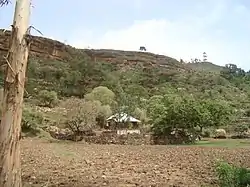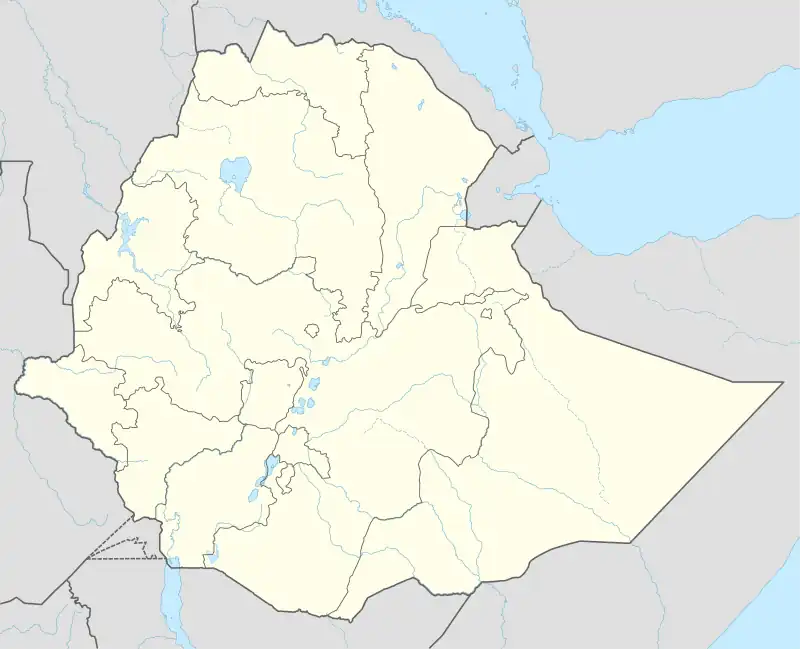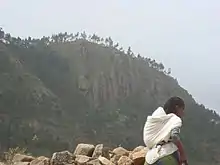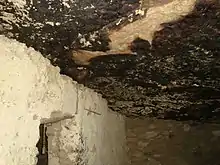Mahbere Sillasie | |
|---|---|
Municipality | |
 Sandstone cliffs where the TPLF cave is located | |
 Mahbere Sillasie Location within Ethiopia | |
| Coordinates: 13°39′N 39°9′E / 13.650°N 39.150°E | |
| Country | Ethiopia |
| Region | Tigray |
| Zone | Debub Misraqawi (Southeastern) |
| Woreda | Dogu'a Tembien |
| Area | |
| • Total | 32.8 km2 (12.7 sq mi) |
| Elevation | 2,580 m (8,460 ft) |
| Population (2007) | |
| • Total | 5,022 |
| • Density | 153/km2 (400/sq mi) |
| Time zone | UTC+3 (EAT) |
Mahbere Sillasie is a tabia or municipality in the Dogu'a Tembien district of the Tigray Region of Ethiopia. The tabia centre is in Guderbo village, located approximately 2.5 km to the west-northwest of the woreda town Hagere Selam.
Geography
The tabia stretches down from the ridge west of Hagere Selam, northbound towards Tsaliet river. The highest peak is just south of Guderbo (2730 m a.s.l.) and the lowest place deep in the Tsaliet gorge (1780 m a.s.l.).


Geology
From the higher to the lower locations, the following geological formations are present:[1]
Climate
The rainfall pattern shows a very high seasonality with 70 to 80% of the annual rain falling in July and August. Mean temperature in Guderbo is 17.4 °C, oscillating between average daily minimum of 9.6 °C and maximum of 24.8 °C. The contrasts between day and night air temperatures are much larger than seasonal contrasts.[2]
Springs
As there are no permanent rivers, the presence of springs is of utmost importance for the local people. The main springs in the tabia are:[3]
- Addi Geza'iti
- May Zeleqo in Guderbo
- Addi Anefti in May Mereb
Reservoirs
In this area with rains that last only for a couple of months per year, reservoirs of different sizes allow harvesting runoff from the rainy season for further use in the dry season. Overall they suffer from siltation.[4] Yet, they strongly contribute to greening the landscape, either through irrigation or seepage water.
- Chini (reservoir), near May Mereb, constructed in 1993
- Traditional surface water harvesting ponds, particularly in places without permanent springs, called rahaya
- Horoyo, household ponds, recently constructed through campaigns – they were particularly studied in Mahbere Sillasie[5]
Settlements
The tabia centre Guderbo holds a few administrative offices, a health post, a primary school, and some small shops.[3] There are a few more primary schools across the tabia. The main other populated places are:[6]
- Addi Geza'iti
- Harehuwa
- Kurkura
- May Mereb
- Waseiya
- Addi Amyuq (half of the settlement, the other half belongs to Selam)
Vegetation and exclosures
The tabia holds several exclosures, areas that are set aside for regreening,[7] such as Harehuwa exclosure. Wood harvesting and livestock range are not allowed there. Besides effects on biodiversity,[8][9][10] water infiltration, protection from flooding, sediment deposition,[11] carbon sequestration,[12] people commonly have economic benefits from these exclosures through grass harvesting, beekeeping and other non-timber forest products.[13] The local inhabitants also consider it as “land set aside for future generations”.[14]
Agriculture and livelihood
Crop farming
The population lives essentially from crop farming, supplemented with off-season work in nearby towns. The land is dominated by farmlands which are clearly demarcated and are cropped every year. Hence the agricultural system is a permanent upland farming system.[15] The farmers have adapted their cropping systems to the spatio-temporal variability in rainfall.[16]
Schools
Almost all children of the tabia are schooled,[17] though in some schools there is lack of classrooms, directly related to the large intake in primary schools over the last decades.[18] Schools in the tabia include the Harehuwa school.
History and culture
History
The history of the tabia is strongly confounded with the history of Tembien. In the 1980s, the TPLF, established its headquarters in a cave in Addi Geza'iti. From these underground rooms and offices cut out in sandstone cliffs, the TPLF carried out its political activities, including a major land reform; it was from here that the offensives were organised till the conquest of Addis Ababa in 1991.
Religion and churches
Most inhabitants are Orthodox Christians. The following churches are located in the tabia:
- Addi Geza'iti Maryam
- Kurkura Mika'el
- Harehuwa Medhanie Alem
- May Mereb Sillasie
- Waseiya Maryam
- Kidane Mihret in the large "Awhi Dur" forest
Inda Siwa, the local beer houses
In the main villages, there are traditional beer houses (Inda Siwa), often in unique settings, which are a good place for resting and chatting with the local people. Most renown in the tabia are[3]
- Kashi Araya Gebreyohannes at Guderbo
- Hndeya Girmay at May Mereb
Roads and communication
The main road Mekelle – Hagere Selam – Abiy Addi runs southeast of the tabia. Further, rural access road link most villages to Guderbo and further to the main asphalt road.
Tourism
Its mountainous nature and proximity to Mekelle makes the tabia fit for tourism.[19]

Tourist attractions
- The scenic views on Tsaliet gorge
- The TPLF caves, which hold also a set of tactical maps used during the Ethiopian Civil War[20]
- The church of Kurkura Mika'el, in a very scenic position in a small forest behind limestone pinnacles, is some 30 years old. Behind it is the remnant of the earlier church established in a natural cave of 20 metres by 20 metres. The roof of the cave is covered with sooth, evidencing the fact that the villagers took cover here, during the Italian bombardments of the Tembien battles in the mid-1930s.
- An open-air museum (under construction), half-way between Guderbo and Hagere Selam
- Awhi Dur, the largest forest of the woreda
Geotourism sites
The high variability of geological formations and the rugged topography invites for geological and geographic tourism or "geotourism".[21] Geosites in the tabia include:
Birdwatching
Birdwatching (for the species, see the main Dogu'a Tembien page) can be done particularly in exclosures and forests. The following bird-watching sites have been inventoried[22] in the tabia and mapped.[6]
- Harehuwa forest
- Awhi Dur forest
Trekking routes
Trekking routes have been established in this tabia.[23] The tracks are not marked on the ground but can be followed using downloaded .GPX files.[24]
- Trek 3, northbound and down across the tabia inside Tsaliet gorge, and then following the river to the rock churches in Addeha
- Trek 4, from Guderbo westbound down to the Dabba Selama monastery
- Trek 5, largely along the ridge on the southern edge of Mahbere Sillasie
Accommodation and facilities
The facilities are very basic.[25] One may be invited to spend the night in a rural homestead or ask permission to pitch a tent. Hotels are available in Hagere Selam and Mekelle.
See also
References
- ↑ Sembroni, A.; Molin, P.; Dramis, F. (2019). Regional geology of the Dogu'a Tembien massif. In: Geo-trekking in Ethiopia's Tropical Mountains - The Dogu'a Tembien District. SpringerNature. ISBN 978-3-030-04954-6.
- ↑ Jacob, M. and colleagues (2019). "Dogu'a Tembien's Tropical Mountain Climate". Geo-trekking in Ethiopia's Tropical Mountains. GeoGuide. SpringerNature. pp. 45–61. doi:10.1007/978-3-030-04955-3_3. ISBN 978-3-030-04954-6. S2CID 199105560.
- 1 2 3 What do we hear from the farmers in Dogu'a Tembien? [in Tigrinya]. Hagere Selam, Ethiopia. 2016. p. 100.
{{cite book}}: CS1 maint: location missing publisher (link) - ↑ Nigussie Haregeweyn, and colleagues (2006). "Reservoirs in Tigray: characteristics and sediment deposition problems". Land Degradation and Development. 17: 211–230. doi:10.1002/ldr.698. S2CID 129834993.
- ↑ Developers and farmers intertwining interventions: the case of rainwater harvesting and food-for-work in Degua Temben, Tigray, Ethiopia
- 1 2 Jacob, M. and colleagues (2019). Geo-trekking map of Dogu'a Tembien (1:50,000). In: Geo-trekking in Ethiopia's Tropical Mountains - The Dogu'a Tembien District. SpringerNature. ISBN 978-3-030-04954-6.
- ↑ Aerts, R; Nyssen, J; Mitiku Haile (2009). "On the difference between "exclosures" and "enclosures" in ecology and the environment". Journal of Arid Environments. 73 (8): 762–763. Bibcode:2009JArEn..73..762A. doi:10.1016/j.jaridenv.2009.01.006.
- ↑ Aerts, R.; Lerouge, F.; November, E. (2019). Birds of forests and open woodlands in the highlands of Dogu'a Tembien. In: Geo-trekking in Ethiopia's Tropical Mountains - The Dogu'a Tembien District. SpringerNature. ISBN 978-3-030-04954-6.
- ↑ Mastewal Yami, and colleagues (2007). "Impact of Area Enclosures on Density and Diversity of Large Wild Mammals: The Case of May Ba'ati, Douga Tembien Woreda, Central Tigray, Ethiopia". East African Journal of Sciences. 1: 1–14.
- ↑ Aerts, R; Lerouge, F; November, E; Lens, L; Hermy, M; Muys, B (2008). "Land rehabilitation and the conservation of birds in a degraded Afromontane landscape in northern Ethiopia". Biodiversity and Conservation. 17: 53–69. doi:10.1007/s10531-007-9230-2. S2CID 37489450.
- ↑ Descheemaeker, K. and colleagues (2006). "Sediment deposition and pedogenesis in exclosures in the Tigray Highlands, Ethiopia". Geoderma. 132 (3–4): 291–314. Bibcode:2006Geode.132..291D. doi:10.1016/j.geoderma.2005.04.027.
- ↑ Wolde Mekuria, and colleagues (2011). "Restoration of Ecosystem Carbon Stocks Following Exclosure Establishment in Communal Grazing Lands in Tigray, Ethiopia". Soil Science Society of America Journal. 75 (1): 246–256. Bibcode:2011SSASJ..75..246M. doi:10.2136/sssaj2010.0176.
- ↑ Bedru Babulo, and colleagues (2006). "Economic valuation methods of forest rehabilitation in exclosures". Journal of the Drylands. 1: 165–170.
- ↑ Jacob, M. and colleagues (2019). Exclosures as Primary Option for Reforestation in Dogu'a Tembien. In: Geo-trekking in Ethiopia's Tropical Mountains - The Dogu'a Tembien District. SpringerNature. ISBN 978-3-030-04954-6.
- ↑ Nyssen, J.; Naudts, J.; De Geyndt, K.; Haile, Mitiku; Poesen, J.; Moeyersons, J.; Deckers, J. (2008). "Soils and land use in the Tigray highlands (Northern Ethiopia)". Land Degradation and Development. 19 (3): 257–274. doi:10.1002/ldr.840. S2CID 128492271.
- ↑ Frankl, A. and colleagues (2013). "The effect of rainfall on spatio‐temporal variability in cropping systems and duration of crop cover in the Northern Ethiopian Highlands". Soil Use and Management. 29 (3): 374–383. doi:10.1111/sum.12041. hdl:1854/LU-3123393. S2CID 95207289.
- ↑ Socio-demographic profile, food insecurity and food-aid based response. In: Geo-trekking in Ethiopia's Tropical Mountains - The Dogu'a Tembien District. SpringerNature. 2019. ISBN 978-3-030-04954-6.
- ↑ Hartjen, Clayton A.; Priyadarsini, S. (2012), Hartjen, Clayton A.; Priyadarsini, S. (eds.), "Denial of Education", The Global Victimization of Children: Problems and Solutions, Boston, MA: Springer US, pp. 271–321, doi:10.1007/978-1-4614-2179-5_8, ISBN 978-1-4614-2179-5, retrieved 2023-10-13
- ↑ Geo-trekking in Ethiopia's Tropical Mountains - The Dogu'a Tembien District. SpringerNature. 2019. ISBN 978-3-030-04954-6.
- ↑ Nyssen, Jan; Petrie, Gordon; Munro, R. Neil; Jacob, Miro; Smidt, Wolbert; Haile, Mitiku; Frankl, Amaury; Billi, Paolo (2019). "Historical Maps, Terrestrial and Aerial Photographs". Geo-trekking in Ethiopia's Tropical Mountains. GeoGuide. SpringerNature. pp. 461–476. doi:10.1007/978-3-030-04955-3_31. ISBN 978-3-030-04954-6. S2CID 199338121.
- ↑ Miruts Hagos and colleagues (2019). "Geosites, Geoheritage, Human-Environment Interactions, and Sustainable Geotourism in Dogu'a Tembien". Geo-trekking in Ethiopia's Tropical Mountains. GeoGuide. SpringerNature. pp. 3–27. doi:10.1007/978-3-030-04955-3_1. ISBN 978-3-030-04954-6. S2CID 199095921.
- ↑ Aerts, R.; Lerouge, F.; November, E. (2019). Birds of forests and open woodlands in the highlands of Dogu'a Tembien. In: Geo-trekking in Ethiopia's Tropical Mountains - The Dogu'a Tembien District. SpringerNature. ISBN 978-3-030-04954-6.
- ↑ Nyssen, Jan (2019). "Description of Trekking Routes in Dogu'a Tembien". Geo-trekking in Ethiopia's Tropical Mountains. GeoGuide. Springer-Nature. pp. 557–675. doi:10.1007/978-3-030-04955-3_38. ISBN 978-3-030-04954-6. S2CID 199271514.
- ↑ "Public GPS Traces tagged with nyssen-jacob-frankl".
- ↑ Nyssen, Jan (2019). "Logistics for the Trekker in a Rural Mountain District of Northern Ethiopia". Geo-trekking in Ethiopia's Tropical Mountains. GeoGuide. Springer-Nature. pp. 537–556. doi:10.1007/978-3-030-04955-3_37. ISBN 978-3-030-04954-6. S2CID 199198251.